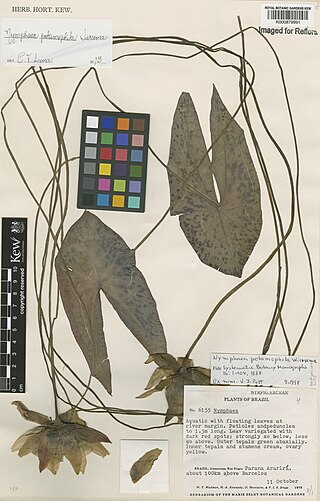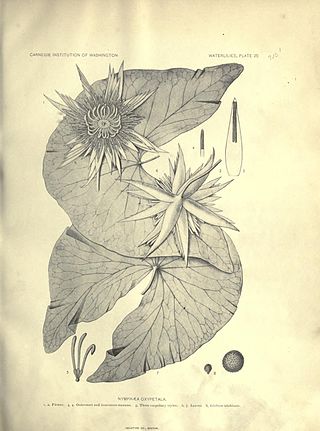
The Araceae are a family of monocotyledonous flowering plants in which flowers are borne on a type of inflorescence called a spadix. The spadix is usually accompanied by, and sometimes partially enclosed in, a spathe. Also known as the arum family, members are often colloquially known as aroids. This family of 140 genera and about 4,075 known species is most diverse in the New World tropics, although also distributed in the Old World tropics and northern temperate regions.

The Nymphaeales are an order of flowering plants, consisting of three families of aquatic plants, the Hydatellaceae, the Cabombaceae, and the Nymphaeaceae. It is one of the three orders of basal angiosperms, an early-diverging grade of flowering plants. At least 10 morphological characters unite the Nymphaeales. One of the traits is the absence of a vascular cambium, which is required to produce both xylem (wood) and phloem, which therefore are missing. Molecular synapomorphies are also known.

Nymphaeaceae is a family of flowering plants, commonly called water lilies. They live as rhizomatous aquatic herbs in temperate and tropical climates around the world. The family contains five genera with about 70 known species. Water lilies are rooted in soil in bodies of water, with leaves and flowers floating on or emergent from the surface. Leaves are round, with a radial notch in Nymphaea and Nuphar, but fully circular in Victoria and Euryale.

Proteales is an order of flowering plants consisting of three families. The Proteales have been recognized by almost all taxonomists.

Ceratophyllaceae is a cosmopolitan family of flowering plants including one living genus commonly found in ponds, marshes, and quiet streams in tropical and in temperate regions. It is the only extant family in the order Ceratophyllales. Species are commonly called coontails or hornworts, although hornwort is also used for unrelated plants of the division Anthocerotophyta.

Nelumbonaceae is a family of aquatic flowering plants. Nelumbo is the sole extant genus, containing Nelumbo lutea, native to North America, and Nelumbo nucifera, widespread in Asia. At least five other genera, Nelumbites, Exnelumbites, Paleonelumbo, Nelumbago, and Notocyamus are known from fossils.

Welwitschiaceae is a family of plants of the order Gnetales with one living species, Welwitschia mirabilis, found in southwestern Africa. Three fossil genera have been recovered from the Crato Formation – late Aptian strata located in the Araripe Basin in northeastern Brazil, with one of these also being known from the early Late Cretaceous (Cenomanian-Turonian) Akrabou Formation of Morocco.

The Cabombaceae are a family of aquatic, herbaceous flowering plants. A common name for its species is water shield. The family is recognised as distinct in the Angiosperm Phylogeny Group IV system (2016). The family consists of two genera of aquatic plants, Brasenia and Cabomba, totalling six species.
Paleontology or palaeontology is the study of prehistoric life forms on Earth through the examination of plant and animal fossils. This includes the study of body fossils, tracks (ichnites), burrows, cast-off parts, fossilised feces (coprolites), palynomorphs and chemical residues. Because humans have encountered fossils for millennia, paleontology has a long history both before and after becoming formalized as a science. This article records significant discoveries and events related to paleontology that occurred or were published in the year 2011.
This article records new taxa of fossil plants that are scheduled to be described during the year 2015, as well as other significant discoveries and events related to paleobotany that are scheduled to occur in the year 2015.
This article records new taxa of plants that were described during the year 2014, as well as other significant discoveries and events related to paleobotany that occurred in the year 2014.
This list of 2013 in paleobotany records new fossil plant taxa that were described during 2013, as well as other significant discoveries and events related to paleobotany that occurred in the year.

Czekanowskiales, also known as Leptostrobales, are an extinct group of seed plants. Members of the family are distinguished by persistent leaves borne on deciduous short shoots, subtended by scale-like leaves. The leaves are highly dissected. They likely grew as trees and shrubs. The main ovulate structure of Czekanowskiales, Leptostrobus, consists of bivalved seed-bearing round capsule-like structures arranged along a long axis. The fossil record of Czekanowskiales is largely confined to the Northern Hemisphere, and they inhabited warm-temperate and temperate climates under humid conditions. The oldest possible records of the group are ovulate cones from the Late Permian of Italy, but the group is primarily known from the Late Triassic onwards, and were abundant during the Jurassic and Early Cretaceous. Only a handful of species are known from the Late Cretaceous, confined to the northern Russian Far East, corresponding to the decline of other seed plant groups during the explosive radiation of flowering plants. The affinites of Czekanowskiales to other seed plants are obscure. A close relationship to the Ginkgoales have been proposed, based on similar preserved molecular signatures of fossil cuticles, with some authors placing Ginkgoales and Czekanowskiales into the broader grouping Ginkgophyta.
This paleobotany list records new fossil plant taxa that were to be described during the year 2012, as well as notes other significant paleobotany discoveries and events which occurred during 2012.

Nymphaea gardneriana is a species of waterlily native to Cuba and tropical South America.

Nymphaea potamophila is a species of waterlily native to the region spanning from Venezuela to northern Brazil. Additionally, it has been reported to occur in Colombia.

Nymphaea oxypetala is a species of waterlily native to Bolivia, Brazil, Cuba, Ecuador, Paraguay, and Venezuela. It is a remarkable species with excessively acuminate and acute sepals and petals.
Nymphaea belophylla is a species of waterlily native to Bolivia, Brazil and Venezuela.

Nymphaea lasiophylla is a species of waterlily native to East Brazil. It has also been introduced to the Venezuelan Antilles.

Nymphaea vanildae is a species of waterlily endemic to Pernambuco, Brazil.













